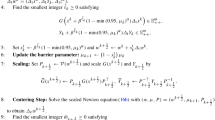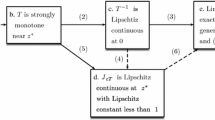Abstract
Recently, numerous research efforts, most of them concerned with superlinear convergence of the duality gap sequence to zero in the Kojima—Mizuno—Yoshise primal-dual interior-point method for linear programming, have as a primary assumption the convergence of the iteration sequence. Yet, except for the case of nondegeneracy (uniqueness of solution), the convergence of the iteration sequence has been an important open question now for some time. In this work we demonstrate that for general problems, under slightly stronger assumptions than those needed for superlinear convergence of the duality gap sequence (except of course the assumption that the iteration sequence converges), the iteration sequence converges. Hence, we have not only established convergence of the iteration sequence for an important class of problems, but have demonstrated that the assumption that the iteration sequence converges is redundant in many of the above mentioned works.
Similar content being viewed by others
References
C.G. Broyden, J.E. Dennis Jr. and J.J. Moré, “On the local and superlinear convergence of quasi-Newton methods,”J. Inst. Math. Appl. 12 (1973) 223–245.
A. El-Bakry, R.A. Tapia and Yin Zhang, “On the use of indicators in identifying zero variables for interior point methods,” Technical Report TR91-15, Dept. Mathematical Sciences, Rice University, 1991; also:SIAM Review 36 (1994) 45–72.
B.R. Gelbaum and John M.H. Olmsted,Counterexamples in Analysis (Holden-Day Inc., San Francisco, 1964).
C. Gonzaga and R.A. Tapia, “On the convergence of the Mizuno—Todd—Ye algorithm to the analytic center of the solution set,” Technical Report TR92-41, Dept. of Computational and Applied Mathematics, Rice University, 1992; also:SIAM Journal on Optimization, to appear.
O. Güler and Y. Ye, “Convergence behavior of some interior-point algorithms,” Working Paper Series No. 91-4, Dept. of Management Sciences, The University of Iowa, 1991.
F. Hausdorff,Mengenlehre (Dover Publications, New York, 1944).
A.J. Hoffman, “On approximate solutions of systems of linear inequalities,”Journal of Research of the National Bureau of Standards 49 (1952) 263–265.
J. Ji, F. Potra, R.A. Tapia and Y. Zhang, “An interior-point method for linear complementarity problems with polynomial complexity and superlinear convergence,” Technical Report TR91-23, Dept. Mathematical Sciences, Rice University, 1991. Submitted for publication.
M. Kojima, Y. Kurita and S. Mizuno, “Large-step interior point algorithms for linear complementarity problems,” Research Report on Information Sciences B-243, Dept. of Information Sciences, Tokyo Institute of Technology, 1991.
M. Kojima, S. Mizuno and A. Yoshise, “A primal-dual interior point method for linear programming,” in: Nimrod Megiddo, ed.,Progress in Mathematical Programming, Interior-point and Related Methods (Springer-Verlag, New York, 1989) pp. 29–47.
I.J. Lustig, R.E. Marsten and D.F. Shanno, “Computational experience with a primal-dual interior point method for linear programming,” Technical Report SOR 89-17, Dept. Civil Eng. and O.R., Princeton University, 1989.
K. McShane, “A superlinearly convergentO(√nL)-iteration primal-dual linear programming algorithm,” Manuscript, 2534 Villanova Drive, Vienna, Virginia, 1991.
K.A. McShane, C.L. Monma and D.F. Shanno, “An implementation of a primal-dual interior point method for linear programming,”ORSA Journal on Computing 1 (1989) 70–83.
N. Megiddo, “Pathways to the optimal set in linear programming,” in: Nimrod Megiddo, ed.,Progress in Mathematical Programming, Interior-point and Related Methods (Springer-Verlag, New York, 1989) pp. 131–158.
S. Mehrotra, “Quadratic convergence in a prima-dual method,” Technical Report 91-15, Department of Industrial Engineering and Management Science, Northwestern University, 1991.
R.D.C. Monteiro and I. Adler, “Interior path-following primal-dual algorithms. Part I: linear programming,”Mathematical Programming 44 (1989) 27–41.
A.M. Ostrowski,Solution of Equations and Systems of Equations (Academic Press, New York, 1966).
M.J. Todd and Y. Ye, “A centered projective algorithm for linear programming,”Mathematics of Operations Research 15 (1990) 508–529.
Y. Ye, O. Güler, R.A. Tapia and Y. Zhang, “A quadratically convergentO(√nL)-iteration algorithm for linear programming,” Technical Report TR91-26, Dept. Mathematical Sciences, Rice University, 1991; Also:Mathematical Programming 59 (1993) 151–162.
Y. Ye, R.A. Tapia and Y. Zhang, “A superlinearly convergentO(√nL)-iteration algorithm for linear programming,” Technical Report TR91-22, Dept. Mathematical Sciences, Rice University, 1991.
Y. Zhang and R.A. Tapia, “A superlinearly convergent polynomial primal-dual interior-point algorithm for linear programming,” Technical Report No. 90-40, Dept. of Mathematical Sciences, Rice University, 1990; also:SIAM Journal on Optimization 3 (1993) 118–133.
Y. Zhang and R.A. Tapia, “On the convergence of interior-point methods to the center of the solution set in linear programming,” Technical Report TR91-30, Dept. of Computational and Applied Mathematics, Rice University, 1991. Submitted for publication.
Y. Zhang and R.A. Tapia, “Superlinear and quadratic convergence of primal-dual interior-point algorithms for linear programming revisited,” Technical Report TR91-27, Dept. of Computational and Applied Mathematics, Rice University, 1991. Has also appeared inJournal of Optimization Theory and Applications 73 (1992) 229–242.
Y. Zhang, R.A. Tapia and J.E. Dennis, “On the superlinear and quadratic convergence of primal-dual interior point linear programming algorithms,” Technical Report TR90-6, Dept. Mathematical Sciences, Rice University, 1990; also:SIAM Journal on Optimization 2 (1992) 304–324.
Y. Zhang, R.A. Tapia and F. Potra, “On the superlinear convergence of interior point algorithms for a general class of problems,” Technical Report TR90-9, Dept. Mathematical Sciences, Rice University, 1990; also:SIAM Journal on Optimization 3 (1993) 413–422.
Author information
Authors and Affiliations
Additional information
This research was supported in part by NSF Coop. Agr. No. CCR-8809615. A part of this research was performed in June, 1991 while the second and the third authors were at Rice University as visiting members of the Center for Research in Parallel Computation.
Corresponding author. Research supported in part by AFOSR 89-0363, DOE DEFG05-86ER25017 and ARO 9DAAL03-90-G-0093.
Research supported in part by NSF DMS-9102761 and DOE DE-FG05-91ER25100.
Research supported in part by NSF DDM-8922636.
Rights and permissions
About this article
Cite this article
Tapia, R.A., Zhang, Y. & Ye, Y. On the convergence of the iteration sequence in primal-dual interior-point methods. Mathematical Programming 68, 141–154 (1995). https://doi.org/10.1007/BF01585761
Received:
Revised:
Issue Date:
DOI: https://doi.org/10.1007/BF01585761




